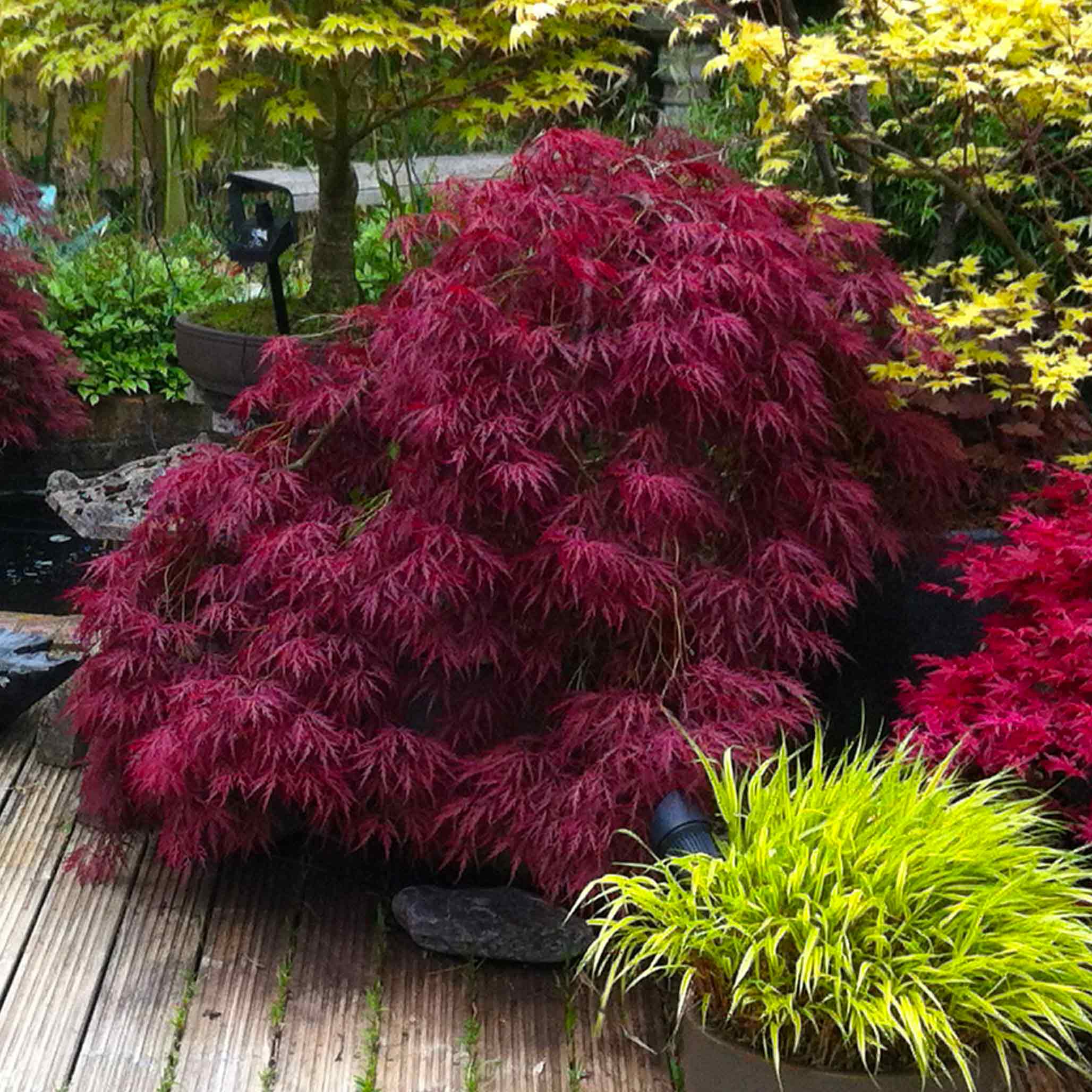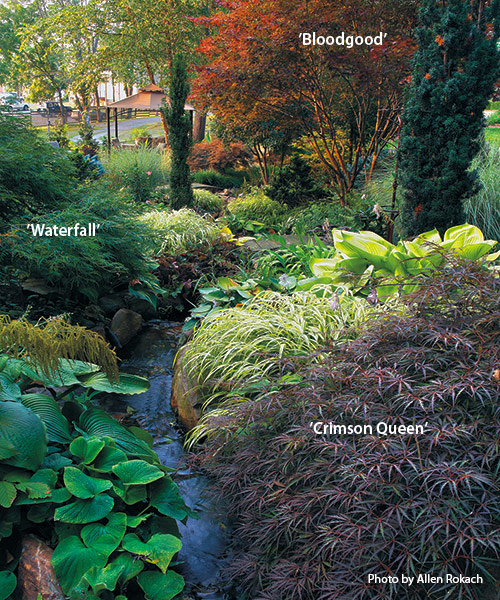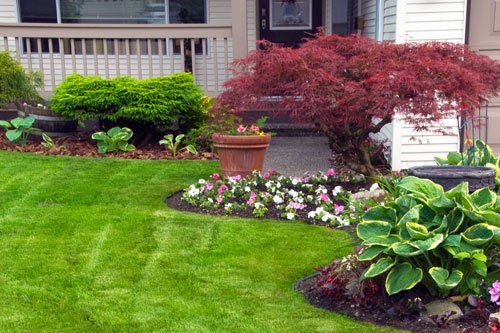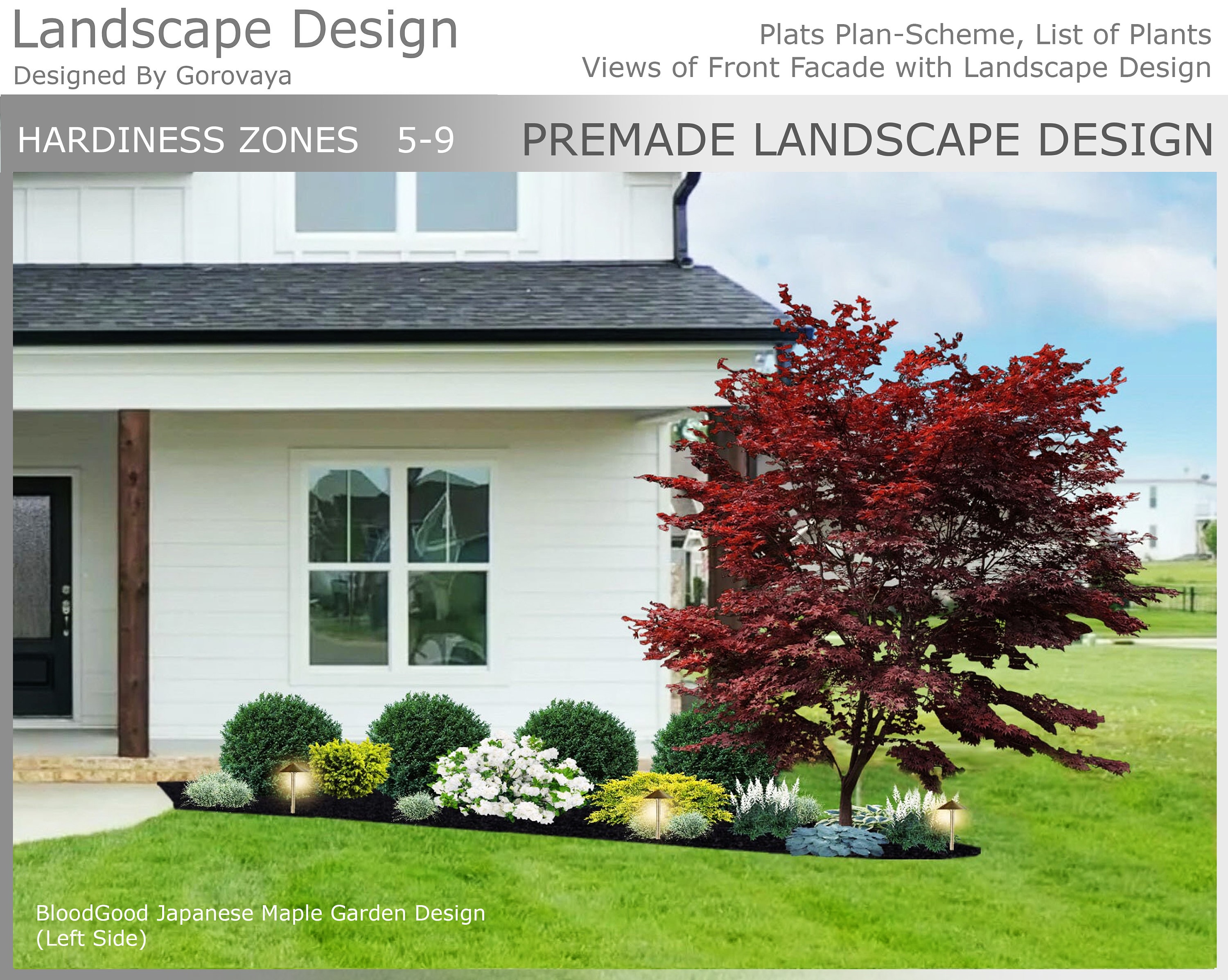
Japanese Maple Landscape Ideas: Transform Your Garden Elegantly
Japanese maple trees create stunning focal points in any landscape. They offer vibrant colors and elegant shapes.
Japanese maple trees, known for their delicate leaves and striking colors, can transform any garden into a serene oasis. Their versatility allows them to fit into various landscape designs, whether as standalone specimens or as part of a mixed planting.
These trees thrive in well-drained soil and partial shade, making them suitable for many garden settings. Pair them with complementary plants like ferns and hostas to enhance their beauty. Japanese maples also work well in container gardens, allowing for greater flexibility in placement. Their year-round interest, from spring blossoms to fall foliage, ensures that your landscape remains captivating throughout the seasons.
Choosing The Right Japanese Maple
Japanese Maples are a stunning addition to any garden. They add color, texture, and elegance. But choosing the right Japanese Maple is crucial for creating the perfect landscape. This involves considering the climate, size, and shape of the tree. Let’s explore how to make the best choice for your garden.
Consider The Climate
Japanese Maples thrive in specific climates. You need to understand your local climate to ensure the tree’s health and longevity. Below are some points to consider:
- Hardiness Zones: Japanese Maples grow best in USDA hardiness zones 5 through 8.
- Temperature: These trees prefer moderate temperatures. They struggle in extreme heat or cold.
- Humidity: Japanese Maples enjoy humid environments. Dry areas may require extra watering.
- Sunlight: They need partial shade. Full sun can scorch the leaves, especially in hot climates.
Refer to the table below for a quick climate guide:
| Climate Factor | Ideal Condition |
|---|---|
| Hardiness Zones | 5-8 |
| Temperature | Moderate |
| Humidity | Humid |
| Sunlight | Partial Shade |
Identify The Desired Size And Shape
Japanese Maples come in various sizes and shapes. Selecting the right one depends on your landscape design. Here are some considerations:
Size: Japanese Maples range from dwarf varieties to larger trees. Dwarf types grow up to 6-8 feet, while larger trees can reach 20-25 feet. Choose based on the space available in your garden.
- Dwarf Varieties: Ideal for small gardens or container planting. Examples include ‘Red Dragon’ and ‘Kiyohime’.
- Medium-Sized Varieties: Suitable for medium-sized gardens. Examples include ‘Bloodgood’ and ‘Emperor I’.
- Large Varieties: Perfect for spacious landscapes. Examples include ‘Osakazuki’ and ‘Sango Kaku’.
Shape: The shape of the Japanese Maple adds to the aesthetic appeal. Common shapes include:
- Weeping: These have a cascading form, creating a waterfall effect. Varieties include ‘Crimson Queen’ and ‘Viridis’.
- Upright: These grow straight and tall, adding vertical interest. Varieties include ‘Moonfire’ and ‘Fireglow’.
- Spreading: These have a wide, horizontal growth pattern. Varieties include ‘Shishigashira’ and ‘Mikawa Yatsubusa’.
By understanding the size and shape, you can choose a Japanese Maple that fits perfectly into your landscape design.
Creating A Japanese Maple Garden
Japanese Maple trees, with their vibrant leaves and elegant branches, can transform any garden into a serene retreat. Creating a Japanese Maple Garden involves thoughtful planning and design. By selecting the right plants, flowers, and hardscape elements, you can elevate your outdoor space, making it a visual delight.
Complementing Plants And Flowers
Choosing the right plants and flowers to complement your Japanese Maple is essential. The right companions enhance the beauty of the Maple while creating a harmonious garden.
Here are some ideal choices:
- Hostas: Their lush green foliage contrasts beautifully with the Maple’s vibrant leaves.
- Ferns: These add a delicate texture, enhancing the overall appeal.
- Azaleas: Their bright blooms provide a striking color contrast.
- Ornamental Grasses: These add height and movement to the garden.
Consider these combinations:
| Plant | Benefit |
|---|---|
| Hostas | Enhances foliage contrast |
| Ferns | Adds texture |
| Azaleas | Color contrast |
| Ornamental Grasses | Height and movement |
Planting these around your Japanese Maple creates a layered effect. The varying heights and textures add depth and interest.
Incorporating Hardscape Elements
Hardscape elements can enhance the beauty of your Japanese Maple Garden. These non-plant features provide structure and definition.
Some effective hardscape options include:
- Stone Pathways: These guide visitors through the garden, adding a rustic charm.
- Bamboo Fences: These add an authentic Japanese feel, providing privacy and structure.
- Water Features: A small pond or fountain adds tranquility with soothing water sounds.
- Garden Benches: These offer a place to sit and enjoy the view.
Consider these hardscape elements:
| Element | Benefit |
|---|---|
| Stone Pathways | Guides visitors, adds charm |
| Bamboo Fences | Privacy, authentic feel |
| Water Features | Tranquility, soothing sounds |
| Garden Benches | Seating, view enjoyment |
These elements create a balanced and serene environment. The combination of plants, flowers, and hardscape elements makes your Japanese Maple Garden a peaceful retreat.
Seasonal Care And Maintenance
Japanese Maples are stunning additions to any landscape, known for their vibrant leaves and elegant forms. To keep these beauties thriving throughout the year, proper seasonal care and maintenance are essential. This guide will provide you with the best practices for pruning, shaping, fertilizing, and watering your Japanese Maples.
Pruning And Shaping
Pruning and shaping your Japanese Maple help maintain its natural form and promote healthy growth. Winter and early spring are the best times to prune your tree. Here are some tips for effective pruning:
- Remove dead or damaged branches to prevent disease.
- Thin out crowded branches to improve air circulation.
- Cut back to a healthy bud or side branch to encourage new growth.
When shaping your Japanese Maple, aim for a balanced and open structure. This not only enhances its beauty but also ensures sunlight reaches all parts of the tree. Use sharp and clean tools to make precise cuts. Here is a quick table to guide your pruning schedule:
| Season | Pruning Task |
|---|---|
| Winter | Remove dead wood, thin crowded branches |
| Early Spring | Shape tree, remove weak branches |
| Summer | Light trimming for shape |
Remember, less is more when pruning. Over-pruning can stress the tree and reduce its natural beauty. Always step back and assess your progress to ensure a balanced look.
Fertilizing And Watering
Proper fertilizing and watering are crucial for the health of your Japanese Maple. These trees prefer a well-drained, slightly acidic soil. Use a balanced, slow-release fertilizer in early spring to boost growth. Here are some key points to keep in mind:
- Fertilize once a year in early spring.
- Use a fertilizer with equal parts nitrogen, phosphorus, and potassium.
- Water deeply but avoid waterlogging the roots.
Japanese Maples need consistent moisture, especially during dry periods. Water your tree early in the morning or late in the evening to minimize evaporation. Here’s a watering schedule to follow:
| Season | Watering Frequency |
|---|---|
| Spring | Twice a week |
| Summer | Three times a week |
| Fall | Once a week |
| Winter | As needed |
Mulching around the base of the tree helps retain moisture and regulate soil temperature. Use organic mulch and keep it a few inches away from the trunk to prevent rot. With the right care, your Japanese Maple will thrive and add year-round beauty to your landscape.

Credit: www.gardengatemagazine.com
Japanese Maple Varieties For Different Landscapes
Japanese Maple trees are a fantastic addition to any landscape. Their vibrant colors, intricate leaves, and unique shapes make them highly desirable. Different varieties suit different landscapes, providing a range of aesthetic options. Below, we explore some popular varieties and their ideal uses.
Weeping Japanese Maples For Elegance
Weeping Japanese Maples create a graceful and elegant look. Their branches droop, forming a cascading effect. These trees are perfect for adding a touch of sophistication to your garden. Popular weeping varieties include:
- ‘Crimson Queen’: Known for its deep red leaves and compact form. It adds a striking color contrast.
- ‘Tamukeyama’: Features delicate, lace-like leaves. Its rich purple-red color is eye-catching.
- ‘Viridis’: Offers bright green foliage. It turns golden and orange in the fall.
Weeping Japanese Maples thrive in partial shade and well-drained soil. They grow slowly, making them low maintenance. Use them as focal points in your garden or near water features for added beauty.
| Variety | Leaf Color | Special Feature |
|---|---|---|
| Crimson Queen | Deep Red | Compact Form |
| Tamukeyama | Purple-Red | Lace-like Leaves |
| Viridis | Bright Green | Golden Fall Color |
Dwarf Japanese Maples For Small Spaces
Dwarf Japanese Maples are ideal for small gardens or container planting. These trees stay compact, rarely exceeding six feet in height. They offer all the beauty of larger maples in a smaller package. Popular dwarf varieties include:
- ‘Shaina’: Known for its dense, bushy form. It features deep red leaves that turn bright red in the fall.
- ‘Coonara Pygmy’: Offers a lovely blend of green and orange leaves. It turns vibrant red in autumn.
- ‘Kiyohime’: Features small, delicate leaves. They start green and turn golden yellow in the fall.
Dwarf Japanese Maples are perfect for adding interest to patios or small garden beds. They require well-drained soil and partial shade. These trees are also excellent for bonsai, allowing you to create miniature landscapes.
| Variety | Leaf Color | Special Feature |
|---|---|---|
| Shaina | Deep Red | Dense, Bushy Form |
| Coonara Pygmy | Green to Orange | Vibrant Red Autumn Color |
| Kiyohime | Green to Yellow | Delicate Leaves |
Enhancing Fall Foliage
Japanese Maple trees are renowned for their stunning fall foliage. Their vibrant reds, oranges, and yellows can transform any landscape into a picturesque scene. Enhancing fall foliage in your garden can create an even more captivating display. Here are some ideas to make your Japanese Maple stand out in the fall.
Adding Companion Plants For Color Contrast
Pairing your Japanese Maple with companion plants can enhance the overall visual appeal. Color contrast plays a crucial role in creating a striking garden landscape. Consider the following options:
- Evergreens – The rich green foliage of evergreens like boxwood or holly provides a beautiful backdrop for the fiery colors of Japanese Maple.
- Ornamental Grasses – Varieties like Miscanthus or Pennisetum add texture and movement, contrasting with the maple’s leaves.
- Perennials – Plants like Hostas and Ferns offer lush, green foliage that complements the maple’s autumn colors.
- Flowering Shrubs – Hydrangeas and Azaleas bloom in shades that contrast nicely with the Japanese Maple.
A well-planned combination of these plants can create a dynamic and colorful garden. Here is a table with some companion plants and their benefits:
| Companion Plant | Benefit |
|---|---|
| Evergreens (Boxwood, Holly) | Provides a green backdrop |
| Ornamental Grasses (Miscanthus, Pennisetum) | Adds texture and movement |
| Perennials (Hostas, Ferns) | Offers lush green foliage |
| Flowering Shrubs (Hydrangeas, Azaleas) | Blooms in complementary colors |
Utilizing Lighting For Dramatic Effect
Proper lighting can make your Japanese Maple the star of your garden, especially in the fall. Strategic lighting highlights the tree’s colors and structure. Consider these lighting ideas:
- Uplighting – Place lights at the base of the tree to shine upwards. This effect creates dramatic shadows and highlights the tree’s structure.
- Spotlighting – Use a focused beam to illuminate key areas. Highlight branches or the tree’s canopy for a stunning effect.
- Backlighting – Position lights behind the tree. This technique creates a silhouette effect, emphasizing the leaves’ colors.
- Path Lighting – Use small lights along garden paths. This not only illuminates the walkway but also enhances the overall ambiance.
Choosing the right type of lighting is crucial. Here is a table with some lighting options and their effects:
| Lighting Type | Effect |
|---|---|
| Uplighting | Creates dramatic shadows |
| Spotlighting | Illuminates key areas |
| Backlighting | Creates silhouette effect |
| Path Lighting | Enhances ambiance |
Combining different lighting techniques can create a visually stunning garden. Experiment with various lights to see what works best for your landscape.
Japanese Maple Landscape Design Mistakes To Avoid
Japanese Maple trees add elegance and beauty to any landscape. They offer vibrant colors and intricate leaf patterns. To maximize their beauty, avoid common design mistakes. Here are some key mistakes to avoid when designing your Japanese Maple landscape.
Overcrowding The Space
Overcrowding your garden space can harm Japanese Maples. These trees need room to grow and spread their branches. Here are some key points to consider:
- Space Requirements: Each Japanese Maple needs 15-20 feet of space. Planting them too close can lead to stunted growth.
- Aesthetic Balance: Crowded spaces make your garden look cluttered. Space out your plants to enhance visual appeal.
- Air Circulation: Proper spacing ensures good air flow. This helps prevent fungal diseases.
Refer to the table below for spacing guidelines:
| Maple Type | Minimum Spacing |
|---|---|
| Small Varieties | 10-15 feet |
| Medium Varieties | 15-20 feet |
| Large Varieties | 20-25 feet |
Avoid planting other large plants too close to your Japanese Maple. They compete for nutrients and water. Also, be mindful of walkways and structures. Trees need space to grow without interference.
Ignoring Soil And Sunlight Requirements
Japanese Maples thrive in specific soil and sunlight conditions. Ignoring these needs can affect their health and beauty. Here are some tips:
- Soil Type: Japanese Maples prefer well-draining, slightly acidic soil. Test your soil pH and amend it if necessary.
- Sunlight Needs: These trees grow best in partial shade. Too much sun can scorch their leaves. Too little can stunt growth.
- Watering: Ensure your soil remains moist but not waterlogged. Overwatering can lead to root rot.
Use the table below for soil and sunlight guidelines:
| Condition | Requirement |
|---|---|
| Soil pH | 5.5-6.5 |
| Sunlight | Partial Shade |
| Watering | Moist, Well-Draining |
Avoid planting in heavy clay soils. They retain too much water and hinder root growth. If your garden lacks shade, consider using shade cloth or planting near taller trees. This provides the needed protection.
Incorporating Japanese Maple In Different Garden Styles
Japanese Maple trees are a stunning addition to any landscape. Their delicate leaves and vibrant colors bring a touch of elegance and tranquility. Incorporating Japanese Maple in different garden styles can transform your outdoor space into a serene retreat. Whether you prefer a traditional Japanese garden or a modern Zen aesthetic, these trees can fit seamlessly into your design.
Traditional Japanese Garden
A traditional Japanese garden focuses on natural beauty and harmony. Japanese Maples are perfect for this setting due to their graceful appearance. Here are some ideas to incorporate these trees into your traditional Japanese garden:
- Water Features: Plant Japanese Maples near koi ponds or waterfalls. Their reflection in the water creates a magical scene.
- Stone Pathways: Line stone pathways with Japanese Maples. The contrast between the stone and the vibrant leaves adds visual interest.
- Tea Garden: Place these trees around a tea house or pavilion. They provide shade and enhance the peaceful ambiance.
Using Japanese Maples in a traditional Japanese garden emphasizes natural beauty and tranquility. Their structure complements the Zen-like qualities of this garden style.
Modern Zen Garden
A modern Zen garden combines simplicity with contemporary design. Japanese Maples can be a focal point in this minimalist setting. Here are some tips:
- Sleek Containers: Use modern, sleek containers for your Japanese Maples. This gives a polished and sophisticated look.
- Gravel and Sand Gardens: Place Japanese Maples in gravel or sand gardens. The simple textures highlight the tree’s intricate details.
- Geometric Layouts: Arrange Japanese Maples in geometric patterns. This creates a modern and organized appearance.
Japanese Maples in a modern Zen garden bring elegance and focus. Their beauty stands out against the garden’s minimalist backdrop.

Credit: www.tedstrees.com
Sourcing And Caring For Healthy Japanese Maple Trees
The Japanese maple tree is a stunning addition to any landscape design, offering beautiful crimson color in autumn and amazing leaves throughout the year. Whether you’re aiming for a dramatic hedge or an Asian-inspired garden, sourcing and caring for healthy Japanese maple trees is crucial. Let’s explore how to choose the right nursery and ensure your tree thrives in your garden.
Choosing A Reputable Nursery
Finding a reputable nursery is essential for sourcing healthy Japanese maple trees. Quality nurseries provide a wide range of beautiful varieties, from compact size trees perfect for container gardening to larger specimens that can become the centerpiece of your yard gardens.
When selecting a nursery, consider these factors:
- Reputation: Look for nurseries with positive reviews and testimonials. Bliss Garden Design and Hanselman Landscape are known for their quality trees.
- Expertise: Choose a nursery with knowledgeable staff who can provide care instructions and advice on suitable varieties for your garden design ideas.
- Selection: Ensure the nursery offers a variety of Japanese maple trees, including dwarf varieties and those with unique features like coral bark or colorful foliage.
Here’s a comparison table to help you evaluate nurseries:
| Nursery | Reputation | Expertise | Selection |
|---|---|---|---|
| Bliss Garden Design | ★★★★★ | ★★★★★ | ★★★★★ |
| Hanselman Landscape | ★★★★☆ | ★★★★☆ | ★★★★☆ |
Transplanting And Acclimating The Tree
Proper transplanting and acclimating of your Japanese maple tree are key to its survival and growth. Follow these steps for success:
- Choose the Right Time: Transplant in early spring or fall to minimize stress on the tree.
- Prepare the Planting Hole: Dig a hole twice the size of the root ball and ensure well-drained soil. Avoid clay-based soil which can retain too much water.
- Position the Tree: Place the tree in the hole, ensuring the root collar is at soil level. Backfill with soil, gently firming it around the roots.
- Watering: Water thoroughly after planting to settle the soil and eliminate air pockets. Continue to water regularly, especially during dry periods.
- Mulching: Apply a layer of mulch around the base, but keep it away from the trunk to prevent rot.
Acclimating the tree involves:
- Partial Shade: Initially, provide partial shade to protect the tree from direct sunlight.
- Gradual Exposure: Gradually increase sunlight exposure to allow the tree to adapt.
- Monitoring: Keep an eye on the tree for signs of stress, such as wilting or leaf drop, and adjust care as needed.
Following these steps ensures your Japanese maple tree establishes well in its new home, adding beauty and color to your landscape designs for years to come.

Credit: www.etsy.com
Frequently Asked Questions
What Looks Good Around A Japanese Maple?
Hostas, ferns, and azaleas look great around a Japanese maple. Use mulch to retain moisture and add visual appeal.
How To Landscape A Japanese Maple?
Plant Japanese maple in well-drained soil. Ensure partial shade and protect from strong winds. Mulch around the base. Water regularly. Prune in late winter to shape and maintain health.
How Far Should Japanese Maple Be From House?
Plant Japanese maples at least 10 feet from your house. This distance allows proper growth and prevents root damage.
Where Is The Best Place To Plant A Japanese Maple Tree?
Plant a Japanese maple tree in well-drained soil with partial shade. Ensure it gets morning sun and afternoon shade. Avoid windy locations.
Conclusion
Japanese Maple trees transform any landscape into a serene oasis. Their vibrant colors and elegant shapes captivate all year round. Whether in a garden or as a focal point, these trees elevate the aesthetic appeal. Embrace Japanese Maple trees for a beautiful, tranquil outdoor space.
Enhance your landscape with their timeless beauty.

